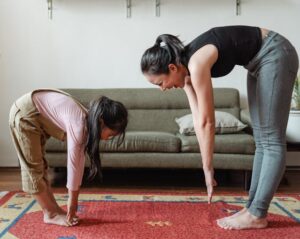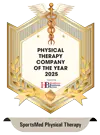Dizziness is a word that strikes fear and uncertainty into the hearts of millions, and 42% of Americans have experienced it at least once. But there’s hope! With vestibular therapy (VRT), a scientifically backed approach for tackling dizziness and balance issues head-on, you can retrain yourself to improve balance and stop the dizziness.
“I’ve worked with people who haven’t laid flat in their beds in over a decade because of dizziness. I find it’s often dismissed, ignored, or they are given poor guidance. I’ll often see someone for joint pain and end up addressing dizziness prior so that they can lay flat and exercise”, Dalton Gilligan, DPT (Vestibular therapy specialist through the American Institute of Balance), said in an interview.
But how effective is VRT? Are the results permanent?
What Is Vestibular Therapy?
Your inner ear constantly signals your brain about your head’s movement and position. This intricate system, called the vestibular system, is crucial for balance, coordination, and understanding your body’s position in relation to your movement.
When the vestibular system malfunctions, it can cause various unpleasant symptoms. Thankfully, VRT offers a non-invasive and effective solution.
This specialized therapy program, designed by a qualified therapist, involves:
- exercises
- canalith repositioning maneuvers (CMPs)
- education about your vestibular system
However, vestibular therapy isn’t a one-size-fits-all treatment. Your therapist will prescribe specific exercises and techniques depending on the underlying cause of your vestibular disorder and your needs.
How Does Vestibular Therapy Work?
Tiny organs within your inner ear (your body’s balance control center), called vestibular canals, sense your head’s movement and send signals to your brain. You can experience dizziness, vertigo, and balance problems when these signals go haywire.
VRT retrains your inner ear and brain. Here’s how it works:
Adaptation, Substitution, Habituation, and Canal Repositioning Techniques
Your brain learns to adjust to confusing signals from your inner ear. Think of it like teaching your eyes to focus in different light conditions.
Other senses, like vision and touch, also help you maintain balance when your inner ear sends these confusing signals.
Repeated movements gradually remove sensitivity to the triggers that cause dizziness, making them less worrying. It builds your tolerance to dizziness and imbalance.
These exercises challenge your eyes to track objects while your head moves, retraining your brain to interpret mixed signals. They also include balance training on stable and unstable surfaces to improve sharpness in all situations.

How a Vestibular Therapist Helps
A vestibular therapist will diagnose the root cause of your dizziness and design a personalized therapy plan based on your needs. They’ll teach you the exercises correctly and gradually increase them as you improve.
Remember that they’ll also be your cheerleader, supporting you every step of the way and celebrating your progress.
Is Vestibular Therapy Effective
Vestibular therapy is effective, and several studies support its effectiveness. A study showed people with mild to moderate brain injuries recovered faster from dizziness and balance problems with 8 weeks of group vestibular therapy compared to those who didn’t get it.
Another study found that people with long-term dizziness felt better after multiple sessions with a vestibular physical therapist than just one session and home exercises.
Lastly, a combined study using both vestibular and cervical therapy helped athletes clear faster to return to sports after concussions compared to those who didn’t receive the combined treatment.
Overall, these studies and many others strongly support the effectiveness of VRT. They also show that vestibular therapy can help you with different conditions, from brain injuries to chronic dizziness and even sports concussions.
How Long Does a Vestibular Therapy Program Last?
The length of vestibular therapy varies. Most people see improvement in 6-8 weeks, but depending on your condition and response, it can range from a few sessions to several months.
Remember, consistency is key when it comes to vestibular therapy. Take it one step at a time and celebrate each step toward achieving a better balance.
Who Can Benefit from Vestibular Therapy?
People with dizziness can benefit from vestibular therapy. Dizziness isn’t just an issue for adults; children can also experience it. This can affect their everyday activities like sports and playing.
In 2018, fall-related injuries among people aged 65 and older led to 3 million visits to the emergency room in the United States, resulting in over 950,000 hospitalizations or transfers to other facilities and around 32,000 deaths.
Dizziness can be a symptom of various medical conditions that affect balance, usually leading to muscle fatigue and headaches.
“BPPV, or Benign Paroxysmal Positional Vertigo is the most common cause of dizziness. While both the cause for dizziness and treatment sound like science fiction, a physical therapist can cure this ailment, usually in 1-3 sessions”, says Gilligan. This is regardless of whether they used vestibular suppressant medications or how long they had been experiencing symptoms.
Generally, VRT can help with conditions such as:
- Dizziness
- Positional vertigo
- Endolymphatic hydrops
- Inner ear infection
- Vestibular neuronitis
- Traumatic brain injury (TBI) and concussions
- Migraine disorder
- Cerebrovascular accident (CVA)
- Risk of falls
What Are the Risks and Side Effects of Vestibular Therapy?
Like any journey, vestibular therapy sometimes comes with temporary bumps.
Luckily, most side effects associated with vestibular therapy are temporary and manageable. Here’s what to expect and how to navigate these common hurdles.
Temporary Side Effects of Vestibular Therapy
Dizziness: Exercise and therapy can – and should – initially trigger temporary dizziness. But this isn’t a cause for alarm. It’s a sign of your inner ear trying to adapt, and it reduces with proper pacing and as you progress.
“Ironically, sometimes when you are dizzy, the worst thing you can do is avoid the dizziness. People typically avoid moving their heads and necks and doing things they like to do. This makes the condition and the anxiety associated with the condition worse. To get better from dizziness, you need to make yourself a little dizzy intentionally!” says Gilligan.
Nausea: Similar to dizziness, nausea can occur but tends to lessen as your body adjusts to the exercises.
Fatigue: Don’t be surprised if therapy leaves you tired, especially at the beginning. Listen to your body and take breaks whenever you need it.
How to Reduce Side Effects of VRT
Start slow and climb gradually: Don’t try to be a hero. Discuss a comfortable progression with your therapist to avoid overloading your system.
Take breaks: Stop the exercise and rest for a while. Remember, you can only make progress, not race to it. Listen to your body; if something feels wrong, stop.
Talk to your therapist: They’re your guide on this journey. Open communication is crucial for adjusting exercises and finding coping strategies tailored to you.

Debunking Myths Surrounding Vestibular Therapy
Dizziness and balance problems can affect anyone, regardless of age. While vestibular therapy (VRT) is sometimes associated with older adults, here’s why those are just myths:
Myth 1: VRT Is Only for Older People.
Untrue! Most people experiencing dizziness, vertigo, or balance issues can benefit from vestibular therapy. Whether you’re a young athlete recovering from a concussion, a busy professional dealing with chronic dizziness, or a senior navigating age-related balance concerns, vestibular therapy can help you.
Myth 2: VRT Doesn’t Provide Lasting Results.
Untrue! Studies show that consistent vestibular therapy exercises, under a qualified therapist’s guidance, can provide long-lasting improvements.
Get Tailored Vestibular Therapy at SportMed Physical Therapy
Vestibular therapy has indeed demonstrated promising effectiveness in managing a range of balance disorders. If you’re looking for patient-focused care, consider consulting with our professionals at SportsMed PT.
With our services spanning Connecticut and New Jersey, we are establishing a benchmark of excellence in physical therapy nationwide.
So, if you’re looking for comprehensive and effective vestibular therapy, SportsMed PT is here to support you every step of the way.



